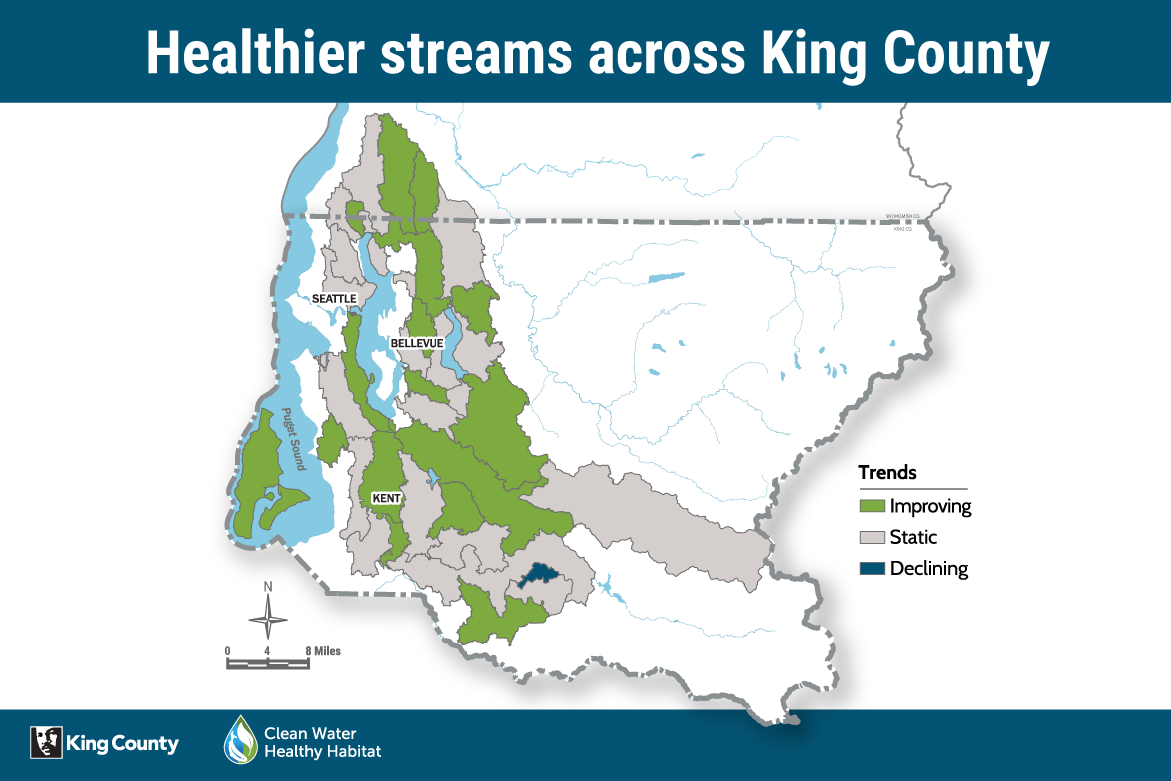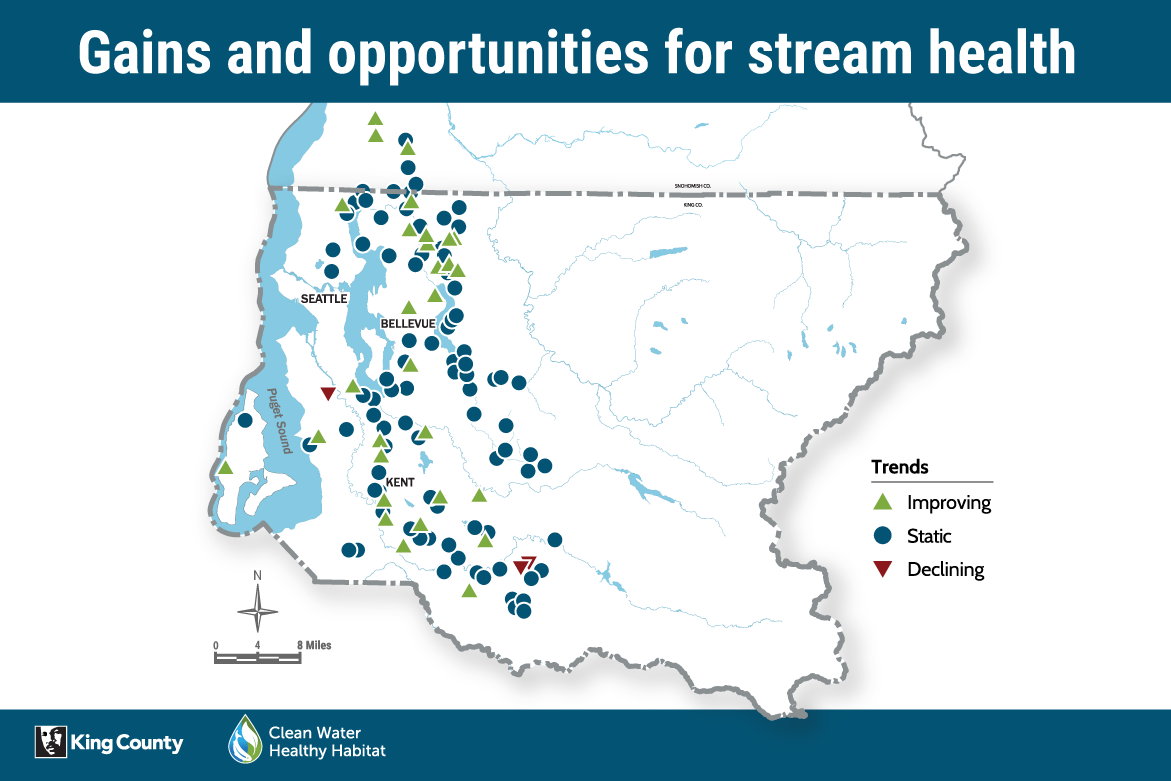Stream health is improving throughout King County – and scientists say there’s even greater potential for additional gains than expected
Summary
Twenty years of data collected by King County scientists indicates widespread improvements in the health of local streams even as the population grew by over a half-million people, suggesting that effective growth management can protect urban streams.
News
Multiple studies based on 20 years of data collected by King County environmental scientists indicate widespread improvements in the health of local streams – and there’s greater opportunity for additional gains than expected.
Twenty-five percent of the streams monitored by the Department of Natural Resources and Parks have improved while just 3 percent have declined. Scientists are trying to determine the precise causes for the healthier conditions, though it appears that effective growth management may be a key factor in improving urban streams even as the county’s population has increased by more than a half-million people.
Streams that were once in very poor health are improving more than previously thought possible, offering hope that even badly damaged streams can improve.
“Thanks to King County field scientists, we now have 20 years of reliable data that sends a consistent, inspiring message: Streams throughout our region are getting healthier, and even those most harmed by human activity can improve when we take the right actions,” said King County Executive Dow Constantine. “This progress shows that we can simultaneously accommodate a growing population and restore the natural environment. Let these positive trends inspire us to achieve even more for people, fish, and wildlife.”
A team of King County environmental scientists has monitored 120 randomly selected streams since 2002, collecting and categorizing aquatic insects to determine the impacts of development and the effectiveness of restoration projects.
The trends study suggests that streams are more resilient than once thought, and even those most impacted by urban development can improve over time and by more than what scientists expected. Conditions are improving in both urban and rural areas with 16 of 38 watersheds improving and just one, Deep Creek, declining.
A related study suggests that recent development causes less harm to streams than older development, indicating that stronger regulations enacted over the past few decades are better protecting water quality.
Water in streams is getting cleaner, too. Over the past 20 years, fecal bacteria has declined in 90 percent of streams. Nitrogen levels are falling in 94 percent. Phosphorous is dropping in 60 percent. Sediment levels are falling in 77 percent. Instead of volatility in stream flow, scientists have seen flow patterns hold steady. Improving trends like these are what scientists expect to see when stormwater and wastewater are regulated and managed effectively.
In addition to effective land use policies and better management of stormwater and wastewater, personal actions likely contributed to the improvements. That includes practicing natural lawn care, fixing oil leaks, taking transit, installing rain gardens, removing noxious weeds, and planting native trees.
Study results ‘tell us something good and real is happening’
The current trends show advancements for three of the six strategic goals established in Clean Water Healthy Habitat, an initiative Executive Constantine launched in 2019 to better align investments and actions to produce better results faster for people, salmon, and orcas. They indicate cleaner, controlled stormwater runoff, reduced toxics and fecal pathogens, and better fish habitat.
Josh Latterell, who leads King County’s Science Section at the Department of Natural Resources and Parks, provided an assessment of the multiple studies:
“By themselves, each of these studies gives us a little hope. But together, they tell us that something real and good is happening. And it’s happening across King County. Scientists get used to delivering bad news. This time, we get to be cautiously optimistic. Our data is telling us that, against expectations, streams are improving. Lake Washington is getting cleaner. It’s reasonable to believe that something about how we are regulating and managing streams and watersheds is working.
“Perhaps we are all responsible, to some degree? When multiplied by 4 or 5 million people, personal choices add up. One of the most hopeful findings, for me, is that unhealthy streams, given the chance, can bounce back. One lesson from this is: Don’t give in to despair. The small sacrifices we make for the environment are not in vain.”
Field research focusing on bugs, a key indicator of watershed health and improvements
The King County environmental scientists who collect and analyze the data that inform trend reports are known as the Stream Team. Much of their field research focuses on bugs, which are key indicators of a watershed’s current condition and its health trends.
Scientists closely monitor benthic macroinvertebrates that live in the gravel, wood, and debris of streams and play a critical role in the nutrient cycle and larger ecosystem. In addition to collecting stream bugs, the team documents characteristics of the streambed. They measure how much shade a stream gets, its width and depth, water temperature, the velocity of waterflow, and the size of rocks.
In addition to its long-term Water Quality Monitoring Program, King County’s team is conducting an innovative experiment to jump-start recovery in a few streams that have not yet improved. They transferred bugs from protected creeks along the Cedar River to several of the streams in 2018, returning to see if any of the bugs persisted. There are some small, preliminary signs that this more active approach to recovery might benefit stream health, though more monitoring is needed to confirm the hypothesis.
Multimedia
- VIDEO: Stream health improving in King County
- VIDEO: Meet King County’s Stream Team
- VIDEO: Media event: Stream health is improving
- PHOTO GALLERY: Stream health improving in King County
- TRACKS: An interactive map of environmental stewardship in King County
Research
- Surprising Improvements in King County Stream Biotic Integrity Despite Increased Urban Development
- Newer development is relatively less harmful than historic development
- Water quality status and trends in 75 King County streams, 2016-2020
- Preliminary results of bug transfer experiment to jump-start stream recovery
Additional reading
- Is modern stormwater management less harmful than older urban development?
- Encyclopedia of Puget Sound: Can ‘bug seeding’ improve the health of local creeks?
- Scientific American: To revive a river, restore its liver
- King County’s Freshwater Macroinvertebrate Monitoring Program
Quote
Thanks to King County field scientists, we now have 20 years of reliable data that sends a consistent, inspiring message: Streams throughout our region are getting healthier, and even those most harmed by human activity can improve when we take the right actions. This progress shows that we can simultaneously accommodate a growing population and restore the natural environment. Let these positive trends inspire us to achieve even more for people, fish, and wildlife.
Contact
Doug Williams, Department of Natural Resources and Parks, 206-477-4543

 Translate
Translate

